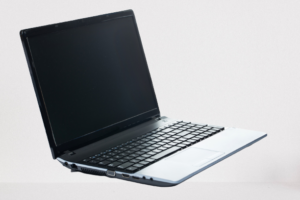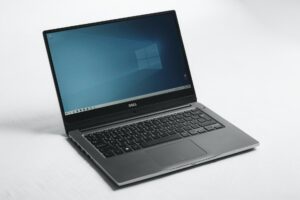Your Dell laptop may refuse to turn on due to different reasons. Whether you’re facing a hardware malfunction or a software glitch, don’t worry. In this guide, TickTockTech will walk you through the steps to bring your Dell PC back to life in no time.
Causes of a Dell Laptop Not Turning On

1. Battery problems
One of the most common reasons why many Dell laptops may not turn on is battery-related issues. The laptop’s battery plays a huge role in providing the power necessary to start up a computer. If the battery is drained, it won’t have the energy to initiate the boot process, even when connected to a power source.
Over time, laptop batteries undergo gradual chemical degradation, leading to a reduction in their capacity. Even if the laptop is connected to the charger, a faulty battery that has reached the end of its lifespan can prevent the laptop from turning on, leaving your Dell laptop non-responsive and seemingly unresponsive. Properly maintaining and monitoring your battery is crucial to keep your Dell laptop in good working condition.
>>Need help with your Laptop?<<
>>Check out our Trusted, USA Based computer repair technicians in Salt Lake City, UT<<
2. Hardware issues
Under this category, several issues may cause your Dell laptop not to turn on. Hardware issues can range from a malfunctioning motherboard, a defective RAM to a faulty processor.
For instance, the motherboard is the main circuit board in a laptop, responsible for connecting and coordinating all the internal components. Consequently, if the motherboard is faulty due to component failure, electrical damage, or manufacturing defects, it can prevent the laptop from starting up altogether.
Another vital component is the RAM (Random Access Memory), which is crucial for temporarily storing data that the laptop’s CPU needs to access quickly. Therefore, if one or more RAM modules are defective, it can hinder the laptop’s ability to complete the boot process or display anything on the screen.
Furthermore, the CPU (Central Processing Unit), the brain of the laptop, handles instructions and performs calculations. As a result, if the CPU is malfunctioning, it may prevent your Dell laptop from initiating the startup process or lead to sudden shutdowns.
3. AC Power Adapter
If the AC power adapter of your PC is malfunctioning or incompatible with the laptop model, it may fail to deliver the necessary power required for startup.
Furthermore, a faulty power adapter can result in an unstable power supply to the laptop due to internal circuitry issues, damage to the adapter’s cable or connectors, or normal wear and tear over time. When the laptop doesn’t receive a consistent and adequate power supply, it may fail to start up or exhibit intermittent power-related problems.
In addition to adapter-related issues, sudden power surges caused by lightning strikes or fluctuations in the electrical grid can damage the AC power adapter or the laptop’s charging circuitry. Also, electrical outages can damage a laptop’s power supply. Cutting off power during operation or charging can cause system errors, data corruption, or issues with your laptop’s power management. As a result, your Dell laptop may refuse to turn on until the power-related anomalies are addressed and resolved.
4. Overheating
Overheating can indeed be another reason why your Dell laptop may refuse to turn on. Over time, laptops can accumulate dust and debris, particularly in the cooling system and fans. When the laptop’s vents are blocked, it can lead to excessive heat buildup within the device. This buildup hinders proper airflow, reducing cooling efficiency and causing the laptop to overheat. In response, the laptop’s safety mechanisms automatically shut it down to prevent potential damage to internal components, and it remains unresponsive until the temperature returns to a safe level.
Furthermore, running resource-intensive applications that heavily load the CPU and GPU can generate more heat. If the laptop’s cooling system cannot cope with the increased heat production, it can also trigger overheating protection mechanisms.
5. OS Errors
The operating system controls the fundamental functions of a computer, including startup, application loading, and file management. However, if the operating system becomes corrupted or infected, it can significantly affect the startup process.
Improper shutdowns, particularly during system updates or software installations, can lead to corrupted boot files, thereby preventing the operating system from initializing correctly during startup.
Additionally, installing incompatible or outdated device drivers or software updates can result in conflicts and errors during startup. Furthermore, conflicts between different software applications can cause system instability and hinder your laptop from starting up properly.
6. Display problems
The display is the visual interface through which we interact with computers and view the output generated by files and applications. When a computer is turned on, the display becomes active, and applications send signals to the graphics hardware to generate visual output. If the display is malfunctioning or disconnected, it can give the impression that the laptop is not turning on.
Physical damages, such as cracks or dead pixels, can lead to a non-functional or distorted display. Similarly, a defective display panel may fail to show any image or remain entirely black.
Additionally, a loose or disconnected display cable that connects the screen to the laptop’s motherboard can result in an unresponsive or flickering display.
7. BIOS problems
BIOS (Basic Input/Output System) is a fundamental firmware on the motherboard for initializing the hardware and loading the operating system. However, if the BIOS encounters problems, it can lead to your Dell laptop not turning on or experiencing difficulties during start up. If the BIOS is corrupted, misconfigured, or incompatible with the hardware, it can prevent the laptop from turning on. This can happen due to different reasons, such as failed BIOS updates, virus or malware attacks, incorrect settings, hardware compatibility problems, or a dead CMOS battery.
How to fix a Dell laptop that won’t Turn on

1. Check the battery
To troubleshoot a Dell laptop that won’t turn on, first, check the battery. If the charger is working correctly but the laptop does not power on, a malfunctioning battery could be the issue. Try powering on the laptop without the battery, unplug the charger, remove the battery, and plug the charger back in. Then press the power button to see if the laptop turns on. If it does, the battery might be faulty. Try charging the laptop while it’s off for an extended period, like overnight, to see if that resolves the problem. If not, you may need to replace the battery with a new one. For laptops with a fixed battery, you may need to open the back cover and disconnect the battery’s cable from the motherboard to troubleshoot the issue.
2. Perform a hard reset
If your Dell laptop refuses to turn on, performing a hard reset can be an effective troubleshooting step. A hard reset is a way to restart your laptop’s hardware and software capable of fixing problems preventing your laptop from turning on.
- Turn off your laptop.
- Disconnect AC Adapter and Remove the Battery (For Dell Laptops with Removable Battery).
- For Dell laptops with removable batteries, refer to your documentation for specific instructions to safely remove the battery. For Dell laptops with non-removable batteries, follow the Dell knowledge base article to reset the Real Time Clock (RTC).
- Disconnect all external devices such as USB drives, printers, webcams, and media cards (SD/xD).
- Press and hold the power button for 15 to 20 seconds to drain residual power.
- Reconnect the AC adapter or power cable and then insert the battery back into the laptop.
- Press the power button to turn on the laptop.
3. Run the Dell PC diagnostic tool
Dell computers have a built-in diagnostic tool that can help you identify problems if your laptop refuses to turn on. This tool can run a series of tests on your laptop’s hardware and software to identify any problem. To run the Dell PC diagnostic tool, follow these steps:
- Ensure your laptop is powered off before proceeding with the diagnostic test.
- Turn on your laptop, as soon as you see the Dell logo, press the F12 key repeatedly until you see the Dell Diagnostics screen.
- Select the Full System test and click Start.
Based on the error codes and messages obtained from the diagnostic test, you can search for the error code online or seek professional help.
4. Remove malware
Viruses and other types of computer infections can make your laptop freeze at startup. If you suspect your laptop is infected with malware, you can try to remove it by booting into safe mode and running antivirus software.
Booting into safe mode:
Safe mode is a diagnostic mode that allows you to start your laptop with only the essential drivers and services. This can help you to identify and troubleshoot problems caused by virus infections or other software conflicts. To enter Safe Mode, restart your laptop, and repeatedly press the F8 key before the Windows logo appears. From the Advanced Boot Options menu, choose “Safe Mode” and press Enter.
Running antivirus software:
In Safe Mode, you can run your installed antivirus software to scan your files and system. Ensure your antivirus software is up to date with the latest virus definitions to detect and remove any potential threats. If the antivirus scan detects any virus, follow the prompts to remove the malicious files from your laptop.
5. Reset the system BIOS
One way to fix a corrupted or misconfigured BIOS is to clear the CMOS. The CMOS is a small battery on the motherboard that stores the BIOS settings. When you clear the CMOS, the BIOS is reset to its default settings. Follow these steps to clear the CMOS:
- Turn off the laptop and disconnect the AC adapter or power cable.
- Locate the CMOS reset jumper on the motherboard. This is usually a small jumper with three pins.
- Short the two pins on the jumper using a jumper cap or a piece of wire.
- Wait for a few minutes, then remove the jumper cap or wire.
- Reconnect the AC adapter or power cable and turn on the laptop.
6. Seek professional help
If you have tried all the troubleshooting steps above and your Dell laptop still won’t turn on, you may need to contact Dell customer support or a certified repair shop for help. These professionals possess the expertise to fix complex problems, providing the best chance of resolving the startup problem and restoring your laptop to its proper functionality.
FAQs on How to fix a Dell laptop that doesn’t Turn on
To troubleshoot a Dell laptop that won’t turn on, first, check the battery. If drained, power the laptop without the battery, and plug in the charger. If the issue persists, try other troubleshooting steps such as performing a hard reset, running Dell PC diagnostic tool, and resetting the system BIOS.
To force your Dell laptop to start, perform a hard reset. This involves turning off your PC and disconnecting the AC adapter and battery (if removable). Then hold the power button for 15-20 seconds and reconnect the AC adapter and battery.
Check the battery, perform a hard reset, run the Dell PC diagnostic tool, remove virus infections in safe mode, and reset the system BIOS by clearing the CMOS. If the issue persists, seek professional help.
If your Dell laptop turns on but does not display, it may be a display-related issue. Check for physical damages, loose cables, or connect to an external monitor to check if the issue is with the laptop’s display.
Conclusion: How to fix a Dell Laptop that won’t Turn on
Your Dell laptop may refuse to turn on for different reasons. To fix this, you can try the troubleshooting steps highlighted in this article. If these steps do not resolve the issue, it is advisable to seek professional help from Dell customer support or a certified repair shop.

